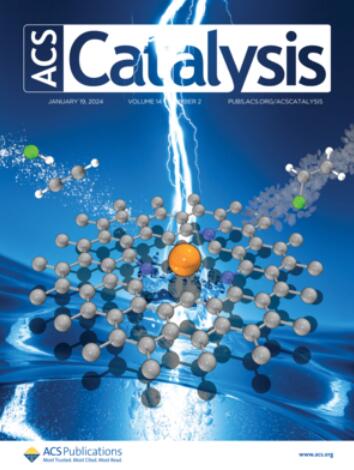Thermally Driven Noncatalytic Reaction Facilitating the Activation of Boron Nitride for the Oxidative Dehydrogenation of Propane
IF 11.3
1区 化学
Q1 CHEMISTRY, PHYSICAL
引用次数: 0
Abstract
Boron nitride (BN) is an active and selective catalyst for the oxidative dehydrogenation (ODH) of propane to propylene. In-situ-generated boron oxyhydroxides during the induction period of reactions are recognized as the key active phase. However, the mechanism of their formation remains elusive because of the complexity of such an ODH reaction involving surface and gas-phase free radical reactions. Herein, we reveal an external thermally driven noncatalytic ODH reaction as the initiation mechanism for BN activation during the induction period, a paradigm distinct from surface-mediated processes, by designing experiments with a confined gas-phase space. Density functional theory (DFT) calculations reveal that the trace amount of H2O, hydroxyl radical (·OH), and hydroperoxyl radical (·OOH) formed during the reaction can cleave the B–N bond of BN to generate boron oxyhydroxides, with a reactivity order of ·OH > H2O > ·OOH. Moreover, propylene can react with ·OOH to form ·OH, accelerating the oxidation process. Such a viewpoint is supported by an observed short induction period in cofeeding propylene and propane experiments, and rapid boron oxyhydroxide formation in ex/in situ characterizations. In contrast, the formation of boron oxyhydroxides is inhibited in the absence of the gas-phase space above the catalyst bed, regardless of propylene addition, confirming the essentiality of thermally induced gas-phase ODH reaction. Finally, a tandem system utilizing in situ-formed propylene was designed to shorten the induction period and promote propane conversion. This study unveils the active phase formation aspect on BN and offers an alternative for designing efficient catalytic systems.

求助全文
约1分钟内获得全文
求助全文
来源期刊

ACS Catalysis
CHEMISTRY, PHYSICAL-
CiteScore
20.80
自引率
6.20%
发文量
1253
审稿时长
1.5 months
期刊介绍:
ACS Catalysis is an esteemed journal that publishes original research in the fields of heterogeneous catalysis, molecular catalysis, and biocatalysis. It offers broad coverage across diverse areas such as life sciences, organometallics and synthesis, photochemistry and electrochemistry, drug discovery and synthesis, materials science, environmental protection, polymer discovery and synthesis, and energy and fuels.
The scope of the journal is to showcase innovative work in various aspects of catalysis. This includes new reactions and novel synthetic approaches utilizing known catalysts, the discovery or modification of new catalysts, elucidation of catalytic mechanisms through cutting-edge investigations, practical enhancements of existing processes, as well as conceptual advances in the field. Contributions to ACS Catalysis can encompass both experimental and theoretical research focused on catalytic molecules, macromolecules, and materials that exhibit catalytic turnover.
 求助内容:
求助内容: 应助结果提醒方式:
应助结果提醒方式:


